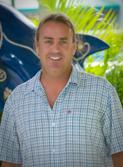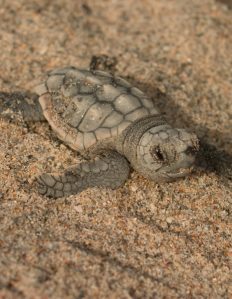Sea turtle nesting season begins on March 1st on Florida’s east coast. Although the ancient underwater reptile has been swimming the world’s oceans for more than 100 million years, even persisting through the mass dinosaur extinction, its survival today is threatened by human activity. Disturbance of nesting beaches jeopardizes the sea turtles’ survival, including development, beach lighting, sea walls, jetties, erosion control structures and nighttime activity on the beach. Participation in the worldwide Lights Out campaign is critical to the livelihood of threatened and endangered sea turtles, as well as an understanding of nesting season do’s and don’ts.

Loggerhead Marinelife Center (LMC) biologist and lead researcher Chris Johnson has studied sea turtles for 15 years. He patrols 9.5 miles of beach in Juno Beach, Jupiter and Tequesta throughout each day of nesting season with a team of six researchers. The team surveys the beaches each morning during nesting season, from March 1st to October 31st each year, counting crawls and nests, and documenting hatch success.
“Dark beaches are more conducive to sea turtle nesting,” explained Johnson, emphasizing the importance of the worldwide Lights Out campaign. “The ancient instincts of hatchlings tell them to head toward the bright horizon, which in the absence of beach lighting, is the ocean.” Lighting near the beach may disorient hatchlings and guide them toward nearby roads, parking lots or parks where they inevitably die. People who live by or are staying near the beach are encouraged to manage beach lighting through the end of nesting season on October 31st. Lights that are needed for human safety should be shielded so they are not visible from the beach or turned off when not needed. Johnson also warns beachgoers should not use flash photography during nesting season, which can also distract and disorient nesting sea turtles and their hatchlings.
In 2010, LMC biologists counted 28,179 total sea turtle crawls on 9.8 miles of shoreline in Juno Beach, Jupiter and Tequesta, compared with 10,309 sea turtle nests. Johnson attributes the difference in nests and crawls mostly to human interference, including activity and debris. “Litter along the beach can obstruct nesting sea turtles and their hatchlings, ultimately putting their survival in danger.” Last year, LMC biologists encountered the body of a sea turtle whose necropsy revealed it suffered a broken neck when it fell into a man-made hole. Johnson suggests any beachgoer can help promote the survival of sea turtles by throwing away foreign objects and filling in holes left behind by people digging in the sand.

Beachgoers should never approach turtles emerging from the sea or disturb turtle nests. Pedestrians and drivers should look out for disoriented hatchlings on trails and roads near the beach. If beachgoers encounter a nesting sea turtle, they are advised to observe from a distance from behind, letting nature take its course. Hatchlings on their way to the ocean should be left alone. If hatchlings seem weak and confused, bring them to Loggerhead Marinelife Center at 14200 US Highway One in Juno Beach, or call Florida Fish and Wildlife Conservation Commission toll-free at 888-404-FWCC. A hatchling drop-off box is available at the front entrance of the center for after-hours drop-off. No action is necessary for empty shells, or exposed un-hatched eggs.
It is illegal to harm or harass sea turtles, their nests or hatchlings. Sea turtles are protected by the US Endangered Species Act of 1973 and Florida Statute Chapter 370. In 1987, the county’s Board of County Commissioners passed the Palm Beach County Sea Turtle Protection Ordinance, one of the first in the state. The County’s Department of Environmental Resources Management (ERM) is responsible for implementing measures designed to protect sea turtles, such as regulating beachfront lighting is in certain areas of the county through the Palm Beach County Unified Land Development Code (ULDC) Article 14.A, Sea Turtle Protection and Sand Preservation Ordinance.
Nesting Season Do’s & Don’ts
Do:
o Throw away foreign objects and debris left behind on the beach
o Fill in holes in the sand which may obstruct a sea turtle’s path to and from the ocean
o Observe a nesting sea turtle from a distance from behind
o Look out for disoriented hatchlings on trails and roads near the beach
o Keep your Lights Out near the beach or install sea turtle-friendly lighting
o Bring weak or confused hatchlings to LMC
Don’t:
o Don’t interact with or disrupt a nesting sea turtle
o Don’t use lighting on the beach at night including flash photography
o Don’t touch hatchlings on their way to the ocean
o Don’t take any action for empty egg shells, or exposed, un-hatched eggs
o Don’t harm or harass sea turtles, their nests or hatchlings
